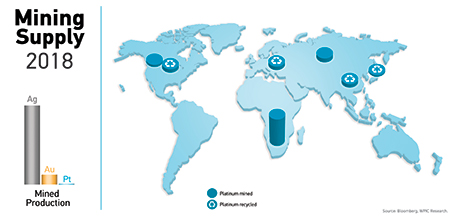When compared to gold and silver mine production the rarity of platinum is highlighted further. In 2018, the mined production of silver, gold and platinum was 860 moz, 108 moz and 6m oz, respectively.
Each year, a further 2 moz (60 metric tons) of platinum comes from mainly autocatalyst and jewellery recycling.
The PGM basket
South Africa’s Merensky ore body has historically dominated global platinum production. Here, platinum is the highest concentration, 50 per cent – 60 per cent. Its sister Platinum Group Metals (PGMs) - palladium, rhodium, ruthenium, iridium and osmium – are present too, alongside base metals like nickel and copper as well as gold and silver.
This means that a platinum mine, established to meet the future growth in global platinum demand, produces a basket of PGMs and other metals for each ounce of platinum mined, refined and sold. The price received by a mining company from the sale of platinum with its sister and other metals, each dependent on the price of the individual metal on global commodity markets, is referred to as the basket price.
Depending on the composition of the ore that is extracted, platinum can be classed as either the primary or secondary metal produced. In South Africa and Zimbabwe, platinum is mined as a primary metal, whereas in Russia platinum is produced predominantly as a by-product of nickel. In North America platinum is produced as a by-product of palladium.


